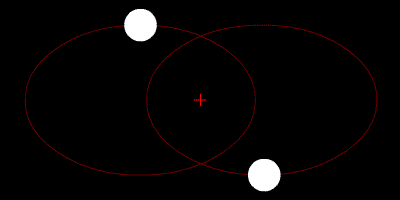Binary star systems do revolve around an "invisble" barycentric point. But, they rotate around it in a flat plane, not a rising and falling sine-wave like path.
Umm, it doesn't work that way. Binary systems are
always changing their distance between one another. Think the Earth and the Moon, think Pluto and Charon, and so on. This is also the reason why the Earth would orbit the sun in an ellipse. If there is a large differential between the masses, the smaller object seems to orbit aound the other, i.e. the sun and planets. If the masses are close, you get something like this.

Now, if you slow the binary orbits down to about once every 365 days, and the Earth rotates beneath it once every 24 or so hours, then Tom's explanation for seasons almost seems almost plausible...except for the reasons I posted above.
The problem with the whole binary thing is that it is made of RE physics, by RE physics, and for RE physics. When you take RE models and throw out some of the entities they're based on (gravitation by mass) you get something that doesn't work. Tom just doesn't understand that and continues to butcher physics as we know it.